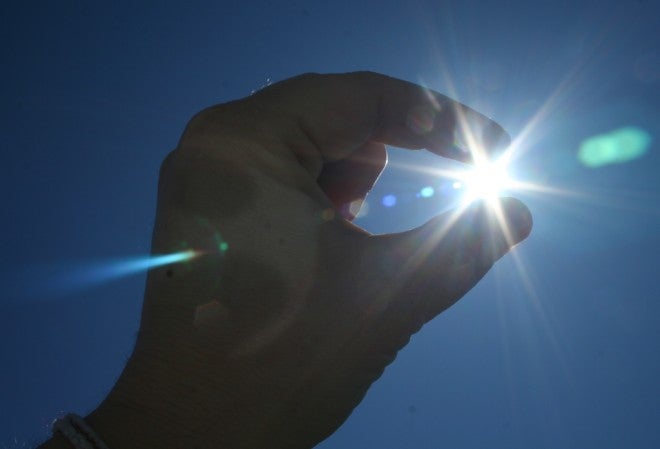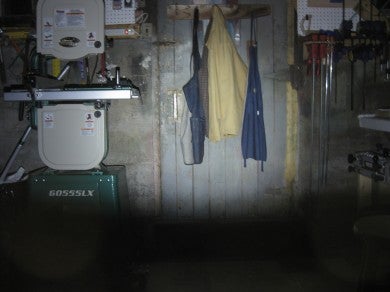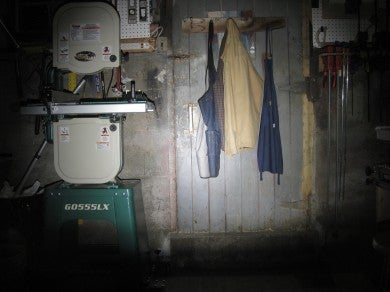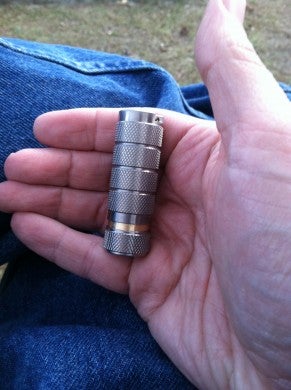PSA for flashlight enthusiasts: the lumens arms race is stupid
Tony Sculimbrene 06.25.13

Yesterday, I got home and saw a small package on my front step. It’s a nice feeling, sort of like Christmas in June. Inside was a pocket-sized star called the EagleTac TX25C2. It has some impressive features–an excellent build quality and pocket clip design–and some insane specs. This is a light smaller in length than the classic 2xAA Mini Mag. Yet, when fully powered up, this little torch throws out 1180 lumens (at least for a few minutes before a step down occurs to save power and prevent overheating). For comparison, your car head lights are about 1000 to 2000 lumens. So this photon cannon runs as bright as you can expect for its form factor — at least right now.
The Lumens Arms Race is a staggering development in modern flashlights, made possible because of improved technology and industry standardization (such as the ANSI standards). With a common measurement method, technology improvements make a clear and direct impact on performance and, concomitantly, product advertising. But the Lumens Arms Race is a sucker’s bet (yes, I am a sucker) for three reasons: 1) the difference between actual lumens and perceived lumens; 2) the need for better color rendering; and 3) the use limitations on high lumens light. In the end, you need something bright, but insanely bright is not necessary for the vast, vast majority of tasks.
Perception is reality
Our eyes are amazing instruments, still unrivaled in this day of techno-marvels. Their dynamic range (perceptions of dim and bright, basically) is massive; their ability to distinguish shades of color (roughly maxing out at 16.7 million colors) is insane; and their time to adjust to bright and dark is remarkable. One fact that is lost on the average consumer is that all of this high performance visual power makes a difference in how we perceive things. Here is a link showing you how lumens increases are perceived by your eyes. Our eyes work logarithmically, so 170 lumens and 210 lumens appear the same.
This means that these “spec bumps” we get from flashlight manufacturers mean literally nothing. When you are researching a light and you see that there is a new model with 10% output increase you can ignore it. You and everyone else in the world will notice no difference. This also means that you can score big, getting “last year’s model” with lower lumens count at a reduced price.
Quality over quantity
What’s the point of carrying and using a flashlight? To see in the dark, right? One of the things that allows you to see in the dark is more lumens, but an often ignored aspect of flashlight output is tint/color rendering. I know there is a difference, but for purposes of an overview, it is best to say that these two aspects of illumination deal with not the amount of light, but the quality of that light. Here is some more information on color rendering. Here is a good comparison between the two:
Normal “Cool Tint”
Hi CRI
The difference is subtle in a picture, but enormous in person.
The Hi CRI emitter produces deep reds, darker blues, and allows your eyes to easily distinguish between similarly colored objects (such as the white background on the safety stickers and taupe tool flywheel housings on the band saw in the picture above). The problem is that some of these bleeding-edge emitters produce huge amounts of light but do so with a sickly, ghostly, or dance party tint and horrible color rendering. They make blues and reds and greens look strange and, in the worst cases, make it hard to distinguish objects even with a flood of photons.
Getting better tints and color rendering involves changing the emitter in a way that drops the total lumens count, but in my experience that trade off is always worth it. You want to see, right? Why not see what is really there. If you have a choice look for emitters that have a neutral tint or better, with a CRI rating of 85 or above. 100 is perfect color rendering, i.e. sunlight. The Nichia 219 emitter is the current record holder for flashlights hitting 93 CRI. There are specialized lighting tools, like those for art galleries or surgical suites (where color rendering REALLY matters), that hit up to 98 CRI.
What are you going to do with that thing?
Try an experiment to see just how useful (or not) all those lumens really are. Turn off all of the lights in your house at night. Sit down with your favorite light and shine it at the ceiling (a “ceiling bounce,” in flashaholic parlance). In most cases, ceilings are white and that means that they will reflect a good deal of light. You will see that you can illuminate most of the room all of the indirect lighting. But as you stare at the ceiling you will notice that very bright light makes it difficult to focus on things on the ceiling, but the much dimmer indirect light is actually very good for getting around in the dark. These photon cannon lights are always too bright in high mode for close up tasks. Even for medium distance tasks (30-50 feet away) the 1000+ lumens counts might STILL be too much. Lower lumens counts might be less sexy, but they are always more useful. In most general tasks, I have found that anything more than 200 lumens is for show or fun (and lighting up a boat at the shore a mile away is fun).
Additionally, if you pay attention to the way you use your light, then you might notice that high is your least used setting. Instead, it is almost always the low that you use the most, so you should pay attention to these numbers more. Ideally you will get a low that won’t blow your night vision (something around 5-10 lumens or less) and will run for ages. The TX25C2 has a low of around 7 lumens that will run for 6 or more days straight. My favorite light right now, the Muyshondt Aeon, Mk. II, runs on a similar lumen count for at least 40 hours, all in a package smaller than a stick of gum.
These long runtimes are, in my mind, vastly more important than blowing people and objects away with a ton of output.
Conclusion
I am not crazy. I know people care about lumens. Lumens are to flashlights what horsepower is to a car. We all love huge engines and massive walls of light. I like lighting up a tree top a mile away. But all that output is basically just fun. The real thing you need to know when you look at lumens numbers is that they don’t really matter as much as people think. 200 lumens usually does everything you will need to do. Tint and color rendering are probably just as important as lumens counts, even if no one outside of Candlepower Forums talks about them. Finally, runtime, especially on low, is something that shouldn’t be ignored. It is the thing you will use the vast majority of time, and it gets hardly any attention. Plus, if you do you time your purchases right, then you can score an awesome light with imperceptibly lower lumens at a huge discount.


